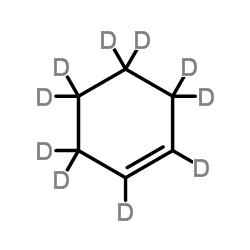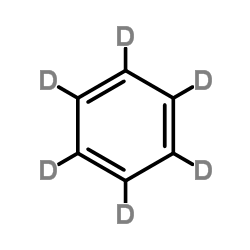1603-55-0
| Name | cyclohexene-d10 |
|---|---|
| Synonyms |
cyclohexene-4-one
decadeuterio-cyclohexene (H)Cyclohexene 3-Cyclohexen-1-one 3-oxocyclohexene Cyclohexene-d Cyclohex-3-enone 3-cyclohexenone |
| Density | 0.8±0.1 g/cm3 |
|---|---|
| Boiling Point | 85.6±7.0 °C at 760 mmHg |
| Melting Point | -104ºC(lit.) |
| Molecular Formula | C6D10 |
| Molecular Weight | 92.205 |
| Flash Point | -12.2±0.0 °C |
| Exact Mass | 92.141022 |
| LogP | 2.89 |
| Vapour Pressure | 77.0±0.1 mmHg at 25°C |
| Index of Refraction | 1.459 |
|
Section1. IDENTIFICATION OF THE SUBSTANCE/MIXTURE Product identifiers Product name: Cyclohexene-d10 CAS-No.: 16035-50-0 Relevant identified uses of the substance or mixture and uses advised against Identified uses: Laboratory chemicals, Manufacture of substances Section2. HAZARDS IDENTIFICATION Classification of the substance or mixture Classification according to Regulation (EC) No 1272/2008 [EU-GHS/CLP] Flammable liquids (Category 2) Acute toxicity, Oral (Category 4) Acute toxicity, Dermal (Category 3) Classification according to EU Directives 67/548/EEC or 1999/45/EC Highly flammable. Harmful in contact with skin and if swallowed. Label elements Labelling according Regulation (EC) No 1272/2008 [CLP] Pictogram Signal wordDanger Hazard statement(s) H225Highly flammable liquid and vapour. H302Harmful if swallowed. H311Toxic in contact with skin. Precautionary statement(s) P210Keep away from heat/sparks/open flames/hot surfaces. - No smoking. P280Wear protective gloves/ protective clothing. P312Call a POISON CENTER or doctor/ physician if you feel unwell. Supplemental Hazardnone Statements According to European Directive 67/548/EEC as amended. Hazard symbol(s) R-phrase(s) R11Highly flammable. R21/22Harmful in contact with skin and if swallowed. S-phrase(s) S16Keep away from sources of ignition - No smoking. S29Do not empty into drains. S33Take precautionary measures against static discharges. S36/37Wear suitable protective clothing and gloves. Other hazards - none Section3. COMPOSITION/INFORMATION ON INGREDIENTS Substances Formula: C6D10 Molecular Weight: 92,21 g/mol ComponentConcentration Cyclohexene-d10 CAS-No.16035-50-0- Section4. FIRST AID MEASURES Description of first aid measures General advice Consult a physician. Show this safety data sheet to the doctor in attendance. If inhaled If breathed in, move person into fresh air. If not breathing, give artificial respiration. Consult a physician. In case of skin contact Wash off with soap and plenty of water. Take victim immediately to hospital. Consult a physician. In case of eye contact Flush eyes with water as a precaution. If swallowed Do NOT induce vomiting. Never give anything by mouth to an unconscious person. Rinse mouth with water. Consult a physician. Most important symptoms and effects, both acute and delayed Exposure to high airborne concentrations can cause anesthetic effects., Nausea, Dizziness, Headache, Central nervous system depression Indication of any immediate medical attention and special treatment needed no data available Section5. FIRE-FIGHTING MEASURES Extinguishing media Suitable extinguishing media Use water spray, alcohol-resistant foam, dry chemical or carbon dioxide. Special hazards arising from the substance or mixture no data available Advice for firefighters Wear self contained breathing apparatus for fire fighting if necessary. Further information Use water spray to cool unopened containers. Section6. ACCIDENTAL RELEASE MEASURES Personal precautions, protective equipment and emergency procedures Wear respiratory protection. Avoid breathing vapors, mist or gas. Ensure adequate ventilation. Remove all sources of ignition. Evacuate personnel to safe areas. Beware of vapours accumulating to form explosive concentrations. Vapours can accumulate in low areas. Environmental precautions Prevent further leakage or spillage if safe to do so. Do not let product enter drains. Discharge into the environment must be avoided. Methods and materials for containment and cleaning up Contain spillage, and then collect with an electrically protected vacuum cleaner or by wet-brushing and place in container for disposal according to local regulations (see section 13). Reference to other sections For disposal see section 13. Section7. HANDLING AND STORAGE Precautions for safe handling Avoid contact with skin and eyes. Avoid inhalation of vapour or mist. Keep away from sources of ignition - No smoking.Take measures to prevent the build up of electrostatic charge. Conditions for safe storage, including any incompatibilities Store in cool place. Keep container tightly closed in a dry and well-ventilated place. Containers which are opened must be carefully resealed and kept upright to prevent leakage. Store under inert gas. hygroscopic Specific end uses no data available Section8. EXPOSURE CONTROLS/PERSONAL PROTECTION Control parameters Components with workplace control parameters Exposure controls Appropriate engineering controls Avoid contact with skin, eyes and clothing. Wash hands before breaks and immediately after handling the product. Personal protective equipment Eye/face protection Face shield and safety glasses Use equipment for eye protection tested and approved under appropriate government standards such as NIOSH (US) or EN 166(EU). Skin protection Handle with gloves. Gloves must be inspected prior to use. Use proper glove removal technique (without touching glove's outer surface) to avoid skin contact with this product. Dispose of contaminated gloves after use in accordance with applicable laws and good laboratory practices. Wash and dry hands. The selected protective gloves have to satisfy the specifications of EU Directive 89/686/EEC and the standard EN 374 derived from it. Body Protection Complete suit protecting against chemicals, Flame retardant antistatic protective clothing, The type of protective equipment must be selected according to the concentration and amount of the dangerous substance at the specific workplace. Respiratory protection Where risk assessment shows air-purifying respirators are appropriate use a full-face respirator with multi-purpose combination (US) or type ABEK (EN 14387) respirator cartridges as a backup to engineering controls. If the respirator is the sole means of protection, use a full-face supplied air respirator. Use respirators and components tested and approved under appropriate government standards such as NIOSH (US) or CEN (EU). Section9. PHYSICAL AND CHEMICAL PROPERTIES Information on basic physical and chemical properties a) AppearanceForm: liquid b) Odourno data available c) Odour Thresholdno data available d) pHno data available e) Melting point/freezingMelting point/range: -104 °C - lit. point f) Initial boiling point and 83 °C - lit. boiling range g) Flash point-12 °C - closed cup h) Evaporation rateno data available i) Flammability (solid, gas) no data available j) Upper/lowerno data available flammability or explosive limits k) Vapour pressureno data available l) Vapour densityno data available m) Relative density0,908 g/mL at 25 °C0,908 g/cm3 at 25 °C n) Water solubilityno data available o) Partition coefficient: n- log Pow: 3,27 octanol/water p) Autoignitionno data available temperature q) Decompositionno data available temperature r) Viscosityno data available s) Explosive propertiesno data available t) Oxidizing propertiesno data available Other safety information no data available Section10. STABILITY AND REACTIVITY Reactivity no data available Chemical stability no data available Possibility of hazardous reactions no data available Conditions to avoid Heat, flames and sparks. Extremes of temperature and direct sunlight. Incompatible materials Strong oxidizing agents Hazardous decomposition products Other decomposition products - no data available Section11. TOXICOLOGICAL INFORMATION Information on toxicological effects Acute toxicity LD50 Oral - rat - 1.940 mg/kg LD50 Oral - rat - 1.944 mg/kg Remarks: Behavioral:Somnolence (general depressed activity). Behavioral:Tremor. Behavioral:Ataxia. LD50 Oral - mouse - > 2.592 mg/kg Remarks: Behavioral:Altered sleep time (including change in righting reflex). Behavioral:Ataxia. Behavioral:Somnolence (general depressed activity). LD50 Dermal - rabbit - > 200 mg/kg Skin corrosion/irritation no data available Serious eye damage/eye irritation no data available Respiratory or skin sensitization no data available Germ cell mutagenicity no data available Carcinogenicity IARC:No component of this product present at levels greater than or equal to 0.1% is identified as probable, possible or confirmed human carcinogen by IARC. Reproductive toxicity no data available Specific target organ toxicity - single exposure no data available Specific target organ toxicity - repeated exposure no data available Aspiration hazard no data available Potential health effects InhalationMay be harmful if inhaled. May cause respiratory tract irritation. IngestionHarmful if swallowed. SkinToxic if absorbed through skin. May cause skin irritation. EyesMay cause eye irritation. Signs and Symptoms of Exposure Exposure to high airborne concentrations can cause anesthetic effects., Nausea, Dizziness, Headache, Central nervous system depression Additional Information RTECS: Not available Section12. ECOLOGICAL INFORMATION Toxicity Toxicity to fishLC50 - Poecilia reticulata (guppy) - 7,1 mg/l - 96 h Persistence and degradability no data available Bioaccumulative potential no data available Mobility in soil no data available Results of PBT and vPvB assessment no data available Other adverse effects Toxic to aquatic life. Section13. DISPOSAL CONSIDERATIONS Waste treatment methods Product Burn in a chemical incinerator equipped with an afterburner and scrubber but exert extra care in igniting as this material is highly flammable. Offer surplus and non-recyclable solutions to a licensed disposal company. Contaminated packaging Dispose of as unused product. Section14. TRANSPORT INFORMATION UN number ADR/RID: 2256IMDG: 2256IATA: 2256 UN proper shipping name ADR/RID: CYCLOHEXENE IMDG: CYCLOHEXENE IATA:Cyclohexene Transport hazard class(es) ADR/RID: 3IMDG: 3IATA: 3 Packaging group ADR/RID: IIIMDG: IIIATA: II Environmental hazards ADR/RID: noIMDG Marine pollutant: noIATA: no Special precautions for user no data available Section15. REGULATORY INFORMATION This safety datasheet complies with the requirements of Regulation (EC) No. 1907/2006. Safety, health and environmental regulations/legislation specific for the substance or mixture no data available Chemical Safety Assessment no data available Section16. OTHER INFORMATION Further information Copyright 2011 Co. License granted to make unlimited paper copies for internal use only. The above information is believed to be correct but does not purport to be all inclusive and shall be used only as a guide. The information in this document is based on the present state of our knowledge and is applicable to the product with regard to appropriate safety precautions. It does not represent any guarantee of the properties of the product. Co., shall not be held liable for any damage resulting from handling or from contact with the above product. See reverse side of invoice or packing slip for additional terms and conditions of sale. |
| Symbol |


GHS02, GHS06 |
|---|---|
| Signal Word | Danger |
| Hazard Statements | H225-H302-H311 |
| Precautionary Statements | P210-P280-P312 |
| Hazard Codes | F: Flammable;Xi: Irritant; |
| Risk Phrases | 11-36/37/38 |
| Safety Phrases | 16-26-36/37/39 |
| RIDADR | UN 2256 3/PG 2 |
|
~94% 
1603-55-0 |
| Literature: Ishibashi, Kenichi; Matsubara, Seijiro Chemistry Letters, 2007 , vol. 36, # 6 p. 724 - 725 |

